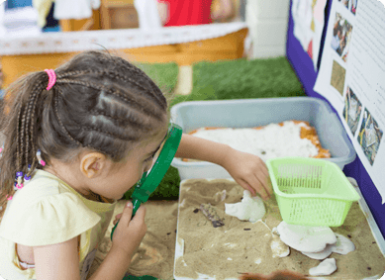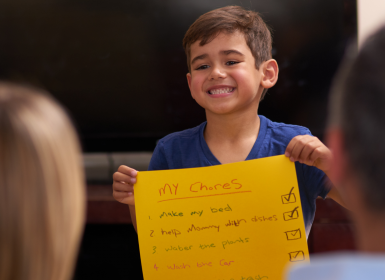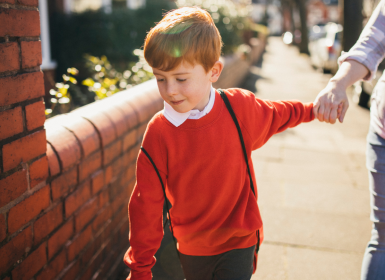What Are Sensory Needs?
Sensory needs are how children receive and respond to information from their environment including what they see, hear, feel, smell and taste. Every child can experience these sensations in their own way. Some children may seek out certain sensations while others may be far more sensitive and find it hard to cope.
To put that into context, think of two children who wear the same jumper. One child may find comfort and security in the texture of the fabric while the other may find it scratchy or irritating.
Understanding these sensory needs helps to create environments and activities that make everyone feel comfortable. This is especially important for children who might have some extra sensitivities. By recognising and supporting these needs, we can ensure that everyone can regulate their feelings to participate in and enjoy their daily experiences.
The Eight Sensory Systems
Understanding the role of each of our sensory systems in our experience of everyday activities can help to identify a child’s individual sensory needs. Each system has a distinct role in processing the sensory information we receive from the world around us and within our own bodies.
Visual System
The sense of sight helps children process visual information such as colour and patterns and track objects with their eyes.
Auditory System
The sense of hearing influences how children respond to different sounds such as spoken words, music or background noise.
Tactile System
The sense of touch influences how children respond to sensations on their skin such as the feel of a soft blanket or the touch of others.
Olfactory System
Our noses help us smell different scents, like fresh cookies baking or flowers blooming in the garden.
Gustatory System
The sense of taste influences a child’s preference for different flavours and food textures like sweet ice cream or sour lemons.
Vestibular System
This system helps children maintain balance and coordinate movements such as jumping or catching a ball.
Proprioceptive System
This system helps children feel the movement of their muscles and joints to understand the position of their body in space such as knowing how high to lift their arm to reach an object.
Interoceptive System
This system helps children feel what’s happening inside their bodies such as feeling hungry, tired or needing to use the bathroom.
Understanding these systems can provide you with valuable insights into your child’s interaction with the world and their unique sensory experiences.
The Relationship Between Behaviour and Sensory Needs
Observing a child’s behaviour can be a useful indicator of their sensory needs. Children often use behaviour to communicate a message or respond to different inputs. Sometimes these behaviours can have negative impacts on others. For example, kicking or punching can hurt others while making loud noises or moving around can be distracting to others. Rather than responding to these behaviours with a consequence, recognise them as a sign that your child is seeking or avoiding a specific sensory input and redirect them towards an activity that can provide that same feeling of safety and wellbeing.
Here are just some things your child’s behaviours could be telling you about their sensory needs.
Hitting, kicking or being rough with people/objects
Physical behaviours provide lots of weight and pressure input to the muscles and joints. If your child is frequently engaging in rough play with their siblings and friends or purposely crashing into objects like their bed, they may be seeking proprioceptive input.
Yelling loudly or banging on objects
Rhythmic sounds and vibrations can be stimulating and regulating for some children. If your child is frequently making loud or repetitive sounds, they may be seeking auditory input.
Jumping, swinging and spinning
Movements that challenge children’s balance and coordination can create different sensations in our bodies. If your child is constantly moving around, they may be seeking vestibular input.
Looking closely at objects or people, making patterns with objects or rubbing eyes
If your child is showing strong interest in shapes, colours and objects, they may be seeking visual input.
Mouthing at non-food objects, chewing or sucking fingers
If your child is frequently placing items in their mouth, they may be seeking tactile or gustatory input.
Strategies to Support Different Sensory Needs
Once you understand the different sensory systems and how your child responds to different inputs, you can provide safe activities to support their sensory exploration and self-regulation. Here are some strategies and activities to try based on your child’s sensory input preferences.
Visual input
- Play ‘I Spy’, spot the difference or seek and find games like Where’s Wally
- Look through a kaleidoscope, cellophane, magnifying glass or binoculars
- Sort items like pom poms or figurines into different colours or sizes
- Play with moving toys like pinwheels, spinning tops or fidget spinners
- Complete puzzles, mazes and dot-to-dots
- Make crafts using colours and patterns such as colouring, threading beads or
- Create visual schedules and routines
- Wear clothes with bright colours and patterns
- Complete activities in front of a mirror
Auditory input
- Play clapping games
- Make your own ‘egg shaker’ instruments filled with different objects like rice, beans and coins
- Play soundscapes, audiobooks or podcasts
- Go on a sound scavenger hunt in the park
- Play with toys that sing or make different sounds
- Dance to your child’s favourite music
- Sing along to daily activities and routines
Tactile input
- Create your own sensory bin with kinetic sand or rice
- Set up messy play activities like play dough or finger painting
- Do some gardening together
- Bake or cook your favourite food
- Read tactile books
- Use a variety of face cloths, loofahs and sponges at bath time
- Use seats with different fabrics like bean bags, foam cushions or fluffy rugs
Olfactory input
- Play with scented play dough
- Use scratch and sniff stickers
- Colour with scented markers, pens or crayons
- Play a ‘guess the smell’ game
- Make scented soaps and candles together
- Use a diffuser
Gustatory input
- Do a blindfolded taste test of your favourite snacks
- Use ‘chewelery’
- Suck on ice cubes or eat crunchy snacks
Vestibular input
- Go to the park to play on the swings, slide, see-saw or merry-go-round
- Bounce or rock on an exercise ball
- Practice cartwheels on the grass
- Ride a bike or scooter
- Jump on a trampoline or mattress (with supervision!)
- Create an obstacle course with balancing and rolling activities
Proprioceptive input
- Crash into cushions
- Roll up in blankets
- Hug or squeeze cushions
- Play bumping games with pillows
- Push/pull/carry heavy objects
- Give bear hugs and firm cuddles
- Set up an obstacle course with crawling, climbing or jumping activities
- Try different yoga poses or animal walks
- Give ‘job’ around the house like carrying the groceries inside
Interoceptive input
- Practice breathing exercises with bubbles or pinwheels
- Try progressive muscle relaxation
Sensory Information in Everyday Environments
Our surroundings constantly provide us with new sensory information, and this can influence a child’s experience of the world around them. When you go to the park in the morning your child may hear distant sounds of birds and children playing, smell grass and flowers and see the colours and patterns on the play equipment. If you then go to the shopping centre, the sensory experience would be completely different.
When entering a new environment, take note of all the different sensations. What sounds can you hear in the background? Are there lots of colours and patterns around? Is it hot or cold? Is there a strong smell?
Smells in the environment
- Cooking smells
- Smells in nature: flowers blooming, garden manure, rain
Sights in the environment
- Light: warm/cool light, brightness
Sounds in the environment
- Nature: rain, wind, waves, thunder, birds chirping, insects buzzing
- Traffic: cars driving, emergency services sirens
- Background noise: fans, air conditioning, music,
Our brains and nervous systems are constantly picking up, filtering out, organisining and adapting to all this sensory information in our environment. Understanding how your child responds to these different sensations is key to creating a supportive sensory-friendly environment and empowering them with the tools to self-regulate.
Learning Links offers Child Psychology services that can help you to better understand your child’s sensory needs and support them to build coping skills if their sensory needs are significantly impacting their wellbeing and ability to function in day-to-day life.





